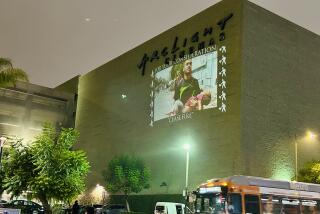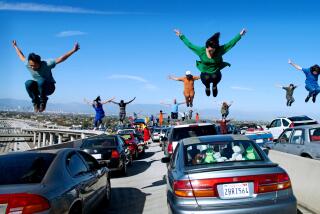O.C. ART / CATHY CURTIS : Tuning Into a Unique Public Work : Language of ‘Video Arch’ Exhibit at the New Arena Is Likely to Be Understood at Some Level by Everyone
- Share via
Orange County’s best public art commission to date is a retinal three-ring circus of electronic imagery at the lavish new Anaheim Arena.
Unveiled last week, “Video Arch,” by internationally known video art pioneer Nam June Paik, is a knockout. It suits the sports-and-entertainment nature of the site, the just-folks potential audience, and the intellectual demands of postmodern art--a triple feat matched by few works of art in the public eye, in Orange County or anywhere else.
The arena was designed by architects Hellmuth, Obata & Kassabaum of Kansas City to cater to a broad, middle-of-the-road audience buying tickets for such events as Mighty Ducks hockey games, boxing and wrestling matches, tennis, motor sports, the circus, the Ice Capades, touring pop and country concerts and religious programming.
Paik proves it is possible to install a genuinely sophisticated work of art whose language is likely to be understood at some level by just about everyone who walks through the arena door--proof that there is an alternative to corporate hunks of abstract art as well as to the sort of corny populism on view at the John Wayne Airport.
Paik’s $175,000 piece, just inside the arena’s steel-and-glass south entrance, is a 13-foot-high archway made of 106 TV monitors arranged in three concentric bands. The monitors, visible from either side of the arch, flash complex patterns of imagery orchestrated by videodiscs. As many as 200 images can be seen in six-minute sequences that keep repeating or recombining for the 30-minute duration of the videodiscs.
Hardly anyone is immune to the mesmerizing effects of video--and at the same time, hardly anything in contemporary culture is as reassuringly familiar as TV. Even Paik’s snazzy, super-fast editing style speaks a language familiar to any watcher of music videos, or even commercials, albeit in a much faster, leaner form.
What with all the special effects at work--imagery that undulates in ribbonlike formations, spinning graphics, “wipes,” picture-in-picture configurations--it is virtually impossible to track everything going on at once in this rippling, flickering electronic universe.
Paik primarily used imagery from his own data bank (leavened by a small percentage of scenes of Anaheim provided by a Citizens Art Advisory Committee, which has worked on the project)--in tandem with a group of art professionals, and under the administration of the city Department of Parks, Recreation and Community Services--for two years.
*
Local color (ballplayers at Anaheim Stadium, cheerleaders, aerobics fanatics, glimpses of streets and freeways, children’s faces, Mickey Mouse) shares the screens with a kaleidoscope of abstract patterns, symbols and signs including music and dance notation, graffiti, a globe, the American flag and a constant stream of zeros and ones reminding the viewer of the binary language of computers.
Computers are crucial to the arena, which is equipped with a centrally hung, 9-by-12-foot video scoreboard that translates the actions of moving people into rows of numbers signifying victory and loss.
In a larger sense, the piece is about the way we receive and process information about the world--the simultaneous, rapid-fire streams of data that bombard us daily, which we acknowledge or reject on the basis of mental processes that have not yet been completely decoded.
A colleague who attended the public opening of the arena last Friday told me that visitors seemed riveted to Paik’s piece but that many believed the imagery was only temporary: During actual hockey games, they expected, the screens would be broadcasting action in the rink, in the fashion of closed-circuit TVs at Anaheim Stadium.
It was an interesting commentary on the “utility” function of TV that video art specifically was created to combat. As Paik recently told an interviewer, “The purpose of video art is . . . to liberate people from TV.”
Clearly, the notion of a TV monitor that doesn’t supply mainstream information or entertainment is still foreign to most people. In the art world, however, 61-year-old Korean-born Paik is a legend, a droll pundit who gets brain waves from the future while others still are baffled by the present.
The idiosyncratic configuration of the monitors in Paik’s work is a major element of his art. The arch form of the piece is based on a key architectural support invented by the ancient Romans, who also used them to commemorate great leaders. In that sense, “Video Arch” wittily pays homage to the triumph of electronic wizardry as well as it echoes the shape of the 70-foot archway framing the entrance.
The big but not overpowering scale of the work seems perfectly suited to the low-slung vastness of the lobby space, and the positioning of the piece between two supporting columns logically avoids the paths of patrons surging toward the food stands or the stadium entrances. The monitors rest on marble bases that harmonize with the luxurious finishes of the interior without sacrificing Paik-style wit: The bases are divided into TV-sized modules, as if the inert slabs of stone somehow are mutating into electronic vivacity.
Technically, the piece seems a marvel of efficiency: The program is said to repeat with barely a pause to rewind, and the imagery on the monitors facing the window remains bright even in strong daylight. At night, however, the piece should be particularly impressive, with its jets of rushing color visible clearly from outside the arena.
The original art plan for the arena also called for a neon work on the roof by Keith Sonnier of New York and hanging banners in the lobby by Renee Petropoulos of Los Angeles. But they fell victim to technical dilemmas. The thin, Fiberglas-lined perforated steel roof was deemed incapable of supporting the Sonnier work (according to art committee chairwoman Julie Mayer, Sonnier declined the offer to make an alternate piece for the arena marquee) and a lower-than-anticipated lobby ceiling made the banner idea impractical.
There will be more commissioned art at the arena, however. The city of Anaheim has invited 85 artists throughout Southern California to submit qualifications for a $200,000 piece to be sited on the skimpy plaza surrounding the facility. Proposals by semifinalists will be presented to the art committee on Sept. 7 and the commission will be awarded Sept. 10. Installation is scheduled for next spring.
Another invitational competition will produce a wall piece for the east lobby, commemorating the arena’s first year of operation. (Eric Martin and Susan Mogul, originally announced as the artists for this work, no longer are associated with the project as a result of Martin’s departure for a teaching position at Harvard.)
The truly amazing thing about the whole project is that a commissioned work by one of the world’s most visionary artists has been installed permanently outside a major U.S. city, in a conservative community, in a sports arena, no less. How did this happen?
*
Marc Pally, art consultant for the project, said, “The thing about Anaheim is, they do things in a big way.” A big way and a daring way.
The art plan for the arena is sound, specifying that work sited there must be “unique and original; an enhancement to the region’s image; appealing to a broad base audience; inviting, entertaining and provocative; and responsive to the architecture and landscaping.”
But in the end, public art depends on getting people with vastly different prejudices and preferences to agree on something they can live with. It’s a tribute to the art committee in Anaheim that its decision came down on the side of risk and excitement and a genuine engagement with contemporary attitudes in art.
* The Anaheim Arena is at 2695 E. Katella Ave., west of the Santa Ana River and east of the Orange Freeway. More of Paik’s art is on view through Sunday at the Newport Harbor Art Museum, 850 San Clemente Drive, Newport Beach. Admission: $4 adults, $2 students and seniors. Hours: 10 a.m. to 5 p.m. daily. (714) 759-1122.
More to Read
The biggest entertainment stories
Get our big stories about Hollywood, film, television, music, arts, culture and more right in your inbox as soon as they publish.
You may occasionally receive promotional content from the Los Angeles Times.










